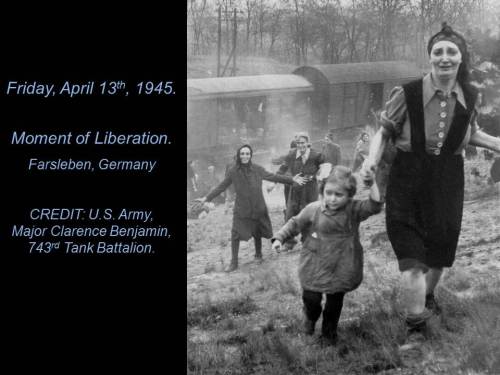Today, April 29th, is the anniversary of the liberation of Dachau, 69 years on. Today, if it is brought up at all, some of us might respond with a vacant stare. More might shrug and turn away. I suppose that is to be expected. But you know me. I just think that as a nation, sometimes we allow things to slip from memory at our peril.
It was real, and it happened. And it was American GIs who overran this camp and many others in the closing days of World War II.
The men of the 42nd and 45th Infantry Division arrived independently of each other, here, in southern Germany, at Dachau, on this day. A concentration camp, they were told. Their noses gave them a hint of what they were about to uncover, miles before the camp appeared in sight.
Read the headlines, above. Note the sub article:
Boxcars of Dead at Dachau. 32,000 captives freed.
And so after some resistance, into the camp they entered. Life changing events were about to unfold for the American soldier.
***************************
For me, it’s not about hero worship, or glorifying the liberator or any World War II soldier as some kind of savior. Many of the liberating soldiers I know would resist this, to the point of rejecting the term, “liberator”… “It all sounds so exalted, so glamorous” said one. But they will all accept the term, “eyewitness”.
Witnesses to the greatest crime in the history of the world.
So instead I think it is about honoring their experiences, their shock, the horror, the puking and the crying, the rage-and then, the American GIs recognizing that something had to be done. And they did suffer for it, for trying to do the right thing. Many tried to help by offering food to starving prisoners who just were not ready to handle it, only to see them drop dead. Or having to manhandle these emaciated victims who were tearing away at each other as food was being offered.
Some guys never got over it. How could you?
I have learned so much over the past few years from these guys, just through the way that they carried themselves and tried to cope with what they witnessed. In my World War II studies and Holocaust class, we discuss these issues at length. I’m so lucky to be able to teach it.
So yesterday, a film crew arrived from NBCLearn, a division of NBC News, all the way up from New York City. No, I did not call them. They found me. They were doing a related story, so I talked them into coming up (shout out here to the producer, Norm).
They decided they wanted to learn something from our kids- ultimately, I think, whether or not history really mattered anymore.
We have had many lessons on the Holocaust, on the victims especially, but also on the perpetrators and the bystanders. Lessons on the liberation, and what we have been studying all along.
These kids have witnessed soldiers’ and survivors’ testimony. They have interviewed their own subjects, firsthand, and established relationships with this generation. And therefore, they become the new witnesses to the deeds of this generation. And with this, they will carry a new responsiblity. To never forget, and to not let others forget, the lessons of the past.
***************************
The raw film is rolling in the classroom. I guess it’s time for me to see what has happened to change the kids. What have they learned, and how have they grown? But today it is time to set the written exam to the side.
We watch the testimony of the liberator who had visited our school in the past, and viewed the archival footage and photographs from 69 years ago.
And then editor poses the questions for the kids. “Why is it important to study the Holocaust? “What difference do you think it makes to know about this, our past? What do you think motivated our soldiers to go off and fight? Was it just “patriotism?”
What did your class learn? What have YOU learned?”
The completed video will be shown in schools across the country. Below are some of the kids of Hudson Falls, who make their small town proud.















